We've been helping the St. Cloud and Twin Cities areas with healthier, greener lawns for over two decades!
Leaf Spot and Melting Out
These are among the most frequent and destructive lawn diseases of common bluegrass. Excess thatch, heavy nitrogen fertilization, excess shade, mowing too close, and broadleaf herbicides promote these diseases. Leaf spot occurs in warm weather and is easily recognized. Spots on the leaves develop purplish-red to purplis-brown borders and brown to tan centers. The spots may extend the width of the leaf and are somewhat longer than wide.

Fusarium Blight
This disease consists of donut-or crescent-shaped areas of dead or dying grass with a center of green grass.
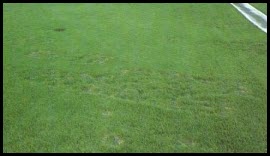
Necrotic Ring Spot
This is a serious disease of Kentucky bluegrass that is especially common on high maintenance lawns. Initial symptoms are patches 6 to 24 inches in diameter with a mixture of normal, staw-and red-colored blades around the outer portion of the ring. Thatch may decompose in the patch areas, giving them a sunken or depressed appearance.
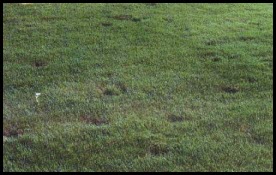
Rhizontonia Yellow Patch
This disease is also a serious disease of Kentucky bluegrass. Since excessively wet conditions favor this disease, it frequently damages new sod laid on heavy soils and it may occur in lawns with heavy thatch and compacted soils. Early symptoms are 2 to 3 inch patches of light green to yellow green grass. These areas soon turn light tan or brown and may increase up to 2 feet in size. The patches may have a sunken appearance due to thatch decomposition. Leaf blades near the margin of the patch may have a reddish to reddish-purple tint, beginning at the leaf tip and continuing downward.
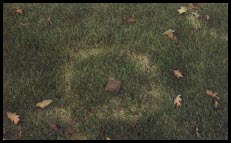
Sclerotinia Dollar Spot
Dollar spot produces 2 to 3 inch circular patches on creeping bentgrass turf and 4 to 6 inch circular to blotchy areas on bluegrass lawns. These patches are straw colored. Early in the morning, when the grass is covered with dew, a faint cobwebby growth may be seen on the leaves of affected plants. In the early stages of disease, leaves develop distinct tan-colored spots and bands; quite often a reddish-brown border can be seen on the spots. Dollar spot develops at temperature of 60 to 85 degrees with high humidity and low soil moisture. The disease usually develops on lawns which are unfertilized, but occasionally occurs on high maintenance lawns under stress.
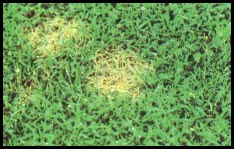
Typhula Blight
The snow molds usually appear in the spring as the snow melts. Roughly circular patches 2 to 40 inches or more in diameter develop. These patches are straw colored, and enlarge as long as the grass remains cold and wet from melting snow. The grass in the patches has a matted appearance, and may have a visible gray colored mold growth on the whole patch or on the advancing margin.
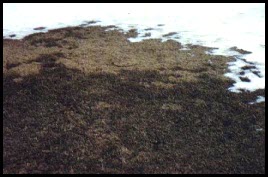
Powdery Mildew
This disease is a common problem on bluegrass lawns in shady areas. The disease attacks the surface of the grass leaves, developing a fine, fungal growth that resembles a white powdery sustance on the leaves. In dense shade, the disease causes the affected areas of leaves to turn yellow, eventually resulting in the yellowing and dying of lower leaves or even in the death of plants. This disease develops in areas of dense shrubbery or trees where there is poor air circulation, considerable shade, and high humidity.
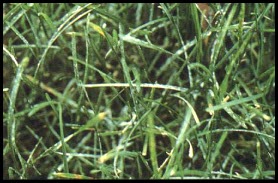
Fusarium Patch
formerly Pink Snow Mold - This disease produces yellowish patches from several inches to a foot in diameter, which usually appear as soon as the snow begins to melt and continue to enlarge as long as the weather is cool and the grass wet. The patches soon take on a bleached appearance. When the greass remains wet, it may be covered by a mat of cottony mold, which is off-white or faint pink. Usually only the leaves of Kentucky bluegrass are killed, but entire plants may be killed in years of severe snow mold activity.

Rust
This disease is not seen every year, but sometimes becomes severe on susceptible varieties during hot periods of the summer when grass growth is reduced. When rust is severe, the lawn may have a yellowish to reddish-orange appearance. A red-orange dust fills the air when the grass is mowed and also collects on shoes and clothing. When rust is severe, the grass blades turn yellow, wither, and die. Rust is favored by humid weather with night temperatures of 70 to 75 degrees, day temperatures of 85 to 95 degrees, wetness from dew lasting many hours after sunrise, and frequent light rain or watering.

Stripe Smut
This is a cool weather disease that sometimes shows up during long periods of cool weather in spring or fall. Lawns with this disease exhibit poor growth and often are patchy, uneven, and thin. Leaves on infected plants develop elongated streaks that are yellow-green, later turn gray, then finally black. When the streaks turn black, the leaf surface is broken and a black powder is liberated from the black streaks. This lengthwise rupturing splits the leaves into narrow strips or ribbons.
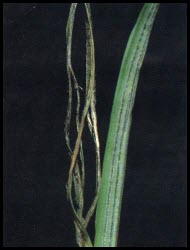
Red Thread
This disease is favored by cool, humid weather and may be more common on lawns with fescue and ryegrass blends. It causes the lawn to have a bleached patchy appearance. Irregular areas, from several inches to several feet across, develop a whitish to pinkish color. Leaf blades and sheaths are attached. At first, the develop water-soaked or greasy green areas, then the affected parts dry out and become tan-colored. In wet weather, the affected leaves are covered with a gelatinous pink fungus, which then forms bright red thread-like strands near the tips of the leaves and from leaf to leaf.
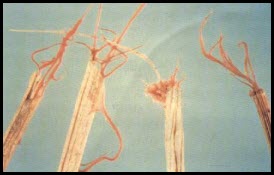
Fairy Rings
Sometimes mushrooms will develop and form large circles in lawns. Each year the circle expands. When these circles are small there may be no effect on the grass, but as they continue to expand, a zone of stimulation forms where the mushrooms come up. Inside this is an area of poor grass growth, or even dead grass. This disease is unsightly and very difficult to control.
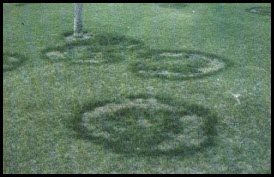
Slime Molds
This disease occasionally forms on grass during periods of prolonged rainfall and high humidity. A creamy white slimy substance accumulates on the grass. Later, this substance becomes powdery and white, gray, or blue-gray. Slime molds do not cause any direct damage to the grass because they only grow over the surface of the leaf and do not attack it. However, they may cause some injury if they remain on the grass for a long period of time.
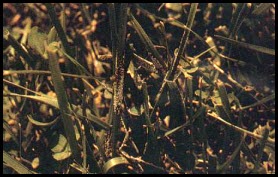
*Illustrations and descriptions provided by Lawn Diseases, North Dakota State University Extension Service, March 1988.

